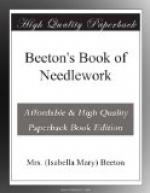Joining the Work.
Place the tatting-pin in the loop that is to be joined, and with the hook draw the thread of the loop—that is, round the hand through it—pass the shuttle through this loop, and draw it up tightly close to the stitches.
A “straight” or double thread is used to join various parts of the work, and forms very beautiful patterns. Without the straight thread we should be unable to imitate point lace patterns, or, indeed, to execute any designs but those composed of circles, ovals, &c. To use this straight thread 2 shuttles are required; they should be of different colours. Sometimes one end of thread is left attached to the reel instead of using the second shuttle. In commencing a loop the straight thread is held between the second and third fingers of the left hand, about 2 or 3 inches from the work; the other shuttle is held as usual in the right hand, and the stitches and purls worked with it upon the foundation of the straight thread of the second shuttle.
* * * * *
TATTING.
1.—Pine Pattern Collar in Tatting.
[Illustration: I.—Pine Pattern Collar in Tatting.]
Materials: Messrs. Walter Evans and Co.’s Boar’s Head cotton No. 80, or tatting cotton No. 60; tatting-pin No. 3; a small shuttle.
This collar is worked with very fine tatting cotton as follows:—1st circle: 2 double, 1 purl 7 times, 2 double, draw up the cotton.
2nd circle: 3 double, join it to the last purl of the 1st circle, 1 double, 1 purl 8 times, 2 double, draw the cotton up.
3rd circle: 2 double, join it to the last purl of the 2nd circle, 1 double, join it to the 7th purl of the 2nd circle, 1 double, 1 purl 8 times, 2 double, draw the cotton up.
4th circle: 2 double, join it to the last purl of 3rd circle, 3 double, 1 purl, 1 double 7 times, 1 double, draw the cotton up.
5th circle: 2 double, join it to the last purl of 4th circle, 2 double, 1 purl, 1 double 3 times, draw up the cotton.
6th circle: 2 double, join it to the last purl of the 5th circle, 1 double, join it to the 5th purl of the preceding circle, 1 double, 1 purl 6 times, 1 double, join it to the first purl of the 1st circle, 2 double, draw up the cotton. This completes the star pattern in centre of pine.




